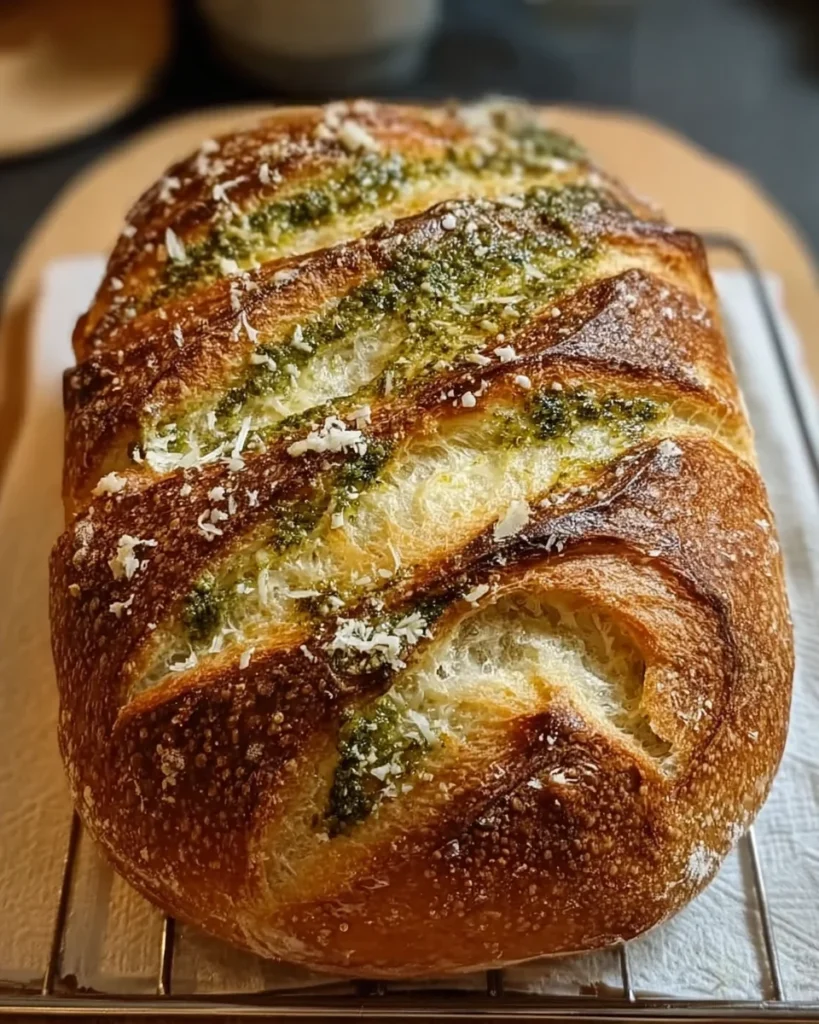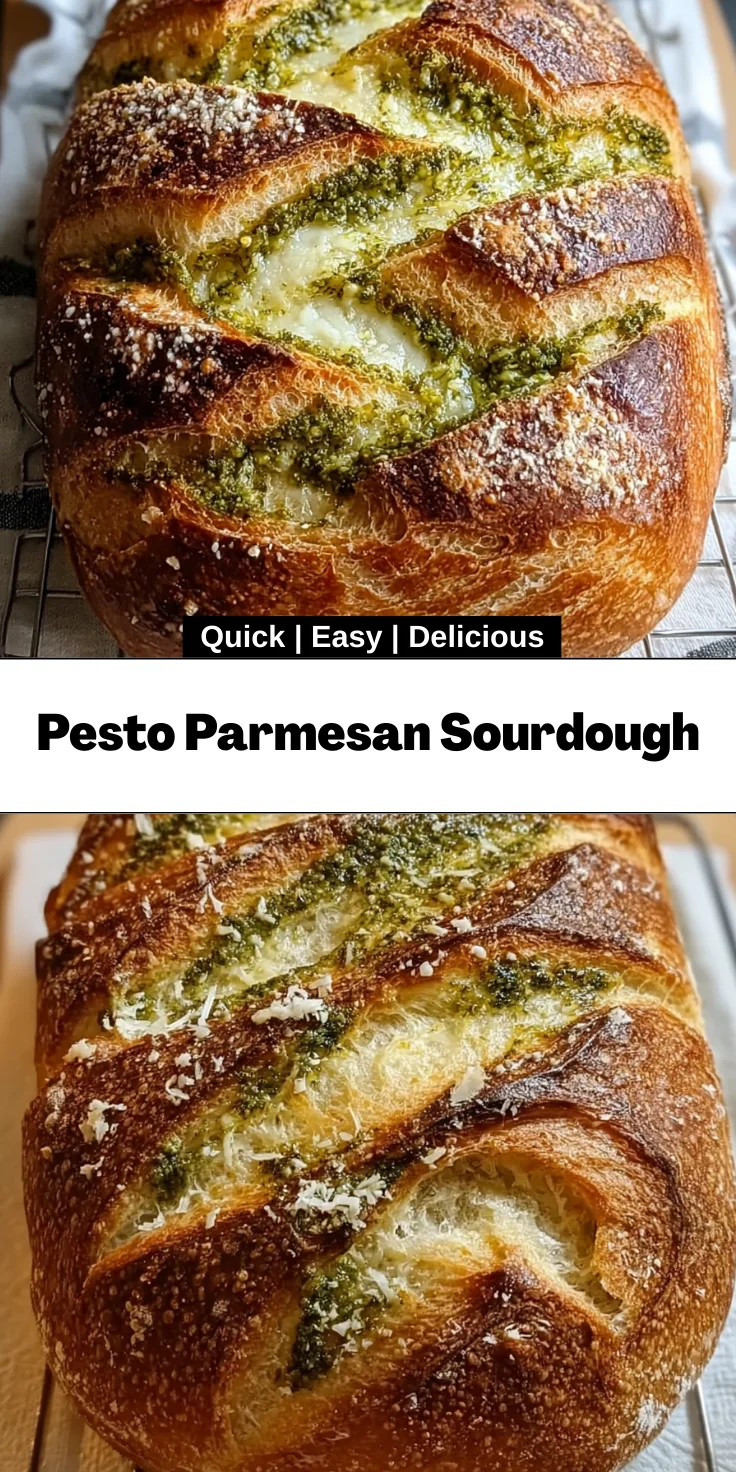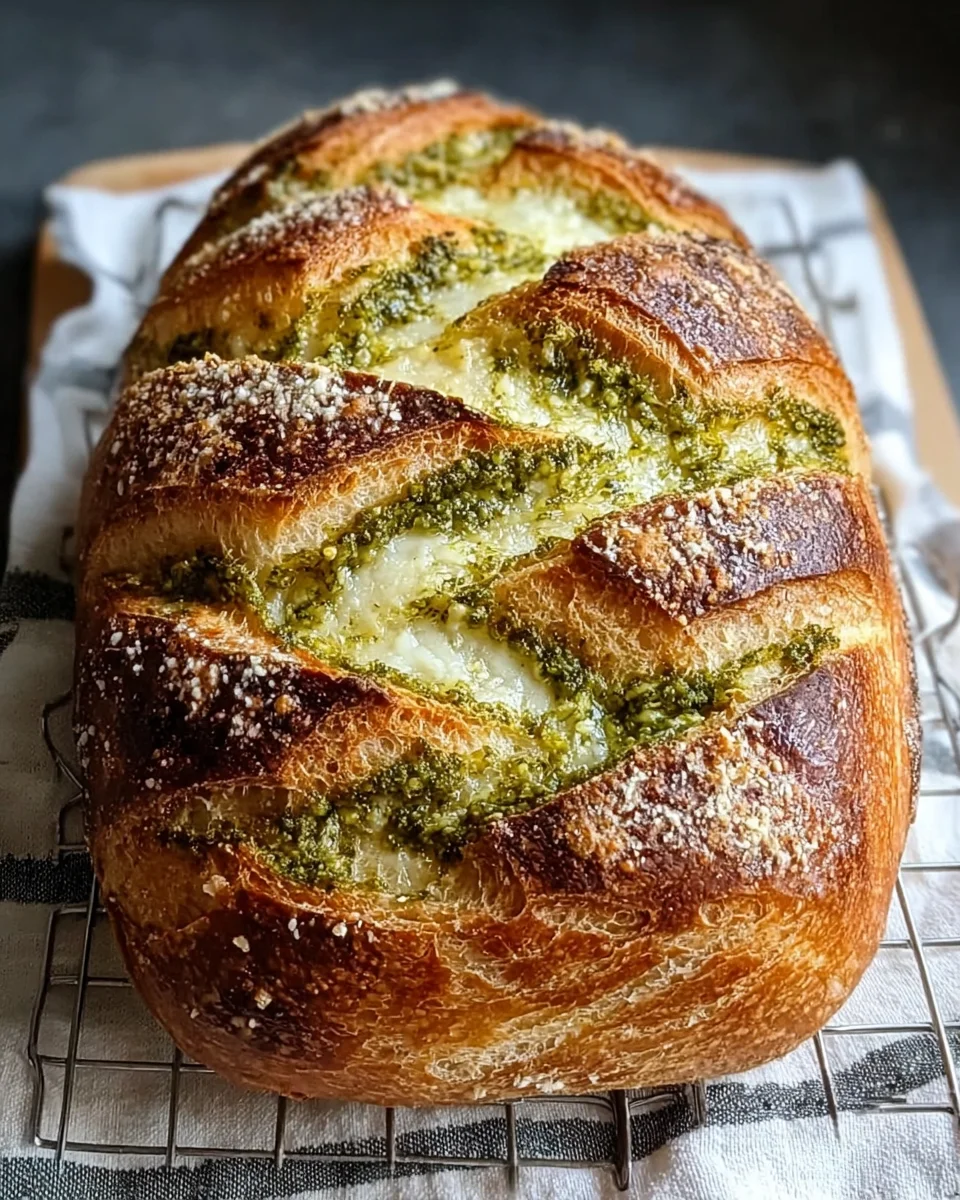
Introduction to Pesto Parmesan Sourdough
Hey there, fellow home cooks! If you’re anything like me, you know the struggle of balancing life’s demands while still wanting to whip up something delicious in the kitchen. That’s where my Pesto Parmesan Sourdough comes into play—a delectable bread that’s not only easy to make but also turns heads at the dinner table! Imagine the comforting aroma wafting through your home as this tangy, cheesy delight bakes away. It’s perfect for quick lunches, elegant dinners, or just snacking with a smear of butter. Ready to elevate your bread game? Let’s dive in!
Why You’ll Love This Pesto Parmesan Sourdough
This Pesto Parmesan Sourdough is a game changer for busy days! It’s an effortless way to create a homemade bread that impresses family and friends alike. You’ll savor the rich flavor of basil pesto blended with nutty parmesan, making every bite a delight. Plus, with the hands-off cold fermentation process, you can enjoy fresh-baked bread with minimal fuss. It’s the perfect fusion of taste and convenience!
Ingredients for Pesto Parmesan Sourdough
Gathering the right ingredients is crucial for creating your delicious Pesto Parmesan Sourdough. Here’s what you’ll need:
- Bread flour: Provides the structure and chewiness essential for sourdough. You can swap in whole wheat flour for a nuttier flavor, but it might alter the texture a bit.
- Sourdough starter: This is your secret ingredient for that signature tang. Make sure it’s active and bubbly for the best rise. Have a bit of starter on hand? You can easily use that!
- Water: Crucial for hydrating the flour and activating the yeast. Filtered or bottled water is ideal, especially if your tap water has strong flavors.
- Salt: Not just for flavor—it strengthens the gluten structure. Use kosher or sea salt for best results, and avoid table salt if you can.
- Basil pesto: The heart of this recipe! Use a good-quality store-bought or homemade pesto. Freshly made pesto gives you a vibrant flavor boost.
- Grated parmesan cheese: Adds a nutty, salty taste that pairs perfectly with the pesto. You might want to experiment with other cheeses, like asiago, for a different twist!
You can find precise measurements for these ingredients at the bottom of the article, where they’re available for printing. Happy gathering!

How to Make Pesto Parmesan Sourdough
Making your own Pesto Parmesan Sourdough might sound daunting, but I promise you it’s easier than it seems. Just follow these simple steps, and soon you’ll have a loaf that will make your kitchen the envy of the neighborhood. Let’s get started!
Step 1: Combine Ingredients
First things first, it’s time to blend the magic ingredients! In a large mixing bowl, combine the bread flour, water, and active sourdough starter. Mix until just combined; you don’t want to work it too much at this point. Allow this mixture to rest for about 30 minutes—this process is called autolyse. It’s vital because it helps develop gluten, leading to a lovely texture once baked.
Step 2: Add Salt
After your dough has rested, it’s time to get salty—in a good way! Sprinkle the salt over the dough and mix it in gently. I usually use my hands; just pinch and fold until it’s well incorporated. This step is crucial because salt strengthens the gluten and helps control fermentation. You’re one step closer to perfection!
Step 3: Stretch and Fold Technique
Now comes the magic part! Every 30 minutes, for the next two hours, perform the stretch and fold technique. Grab a corner of the dough, stretch it up, and fold it over itself. Repeat this on all four sides. This technique is essential for developing gluten, giving the bread that wonderful chewy texture. Trust me, your patience will pay off!
Step 4: Incorporate Pesto and Parmesan
After your dough has finished its stretch and fold, it’s time to add the star ingredients! Gently spread the dough on a lightly floured surface and layer it with basil pesto and grated parmesan cheese. Think of it as a flavorful blanket for your dough. Once nicely spread, fold the dough over itself to encase the fillings. Shape it into a ball—don’t worry, it doesn’t have to be perfect!
Step 5: Cold Fermentation
This is where the real magic happens! Place the shaped dough into a floured banneton or a bowl lined with a floured towel. Cover it and let it chill in the refrigerator overnight. The cold fermentation not only enhances the flavor but also makes the dough easier to work with!
Step 6: Bake the Bread
When you’re ready to bake, preheat your oven to 475°F (245°C), placing a Dutch oven inside to heat up. Once fully heated, gently turn the dough out onto parchment paper and score the top with a sharp blade for that artisan look. Transfer the dough into the hot Dutch oven and cover it. Bake for 20 minutes, then remove the lid and let it bake for another 25 minutes. Look for a nice golden crust—it’s like the bread is singing, “I’m ready!”
Tips for Success
- Make sure your sourdough starter is active and bubbly; feed it a few hours before using.
- Use room temperature water for better fermentation.
- During stretch and folds, don’t rush—take your time for best gluten development.
- Cover your dough during fermentation to prevent it from drying out.
- Let your bread cool completely before slicing to retain moisture and texture.
Equipment Needed
- Mixing bowl: A standard bowl works, but you can also use a dough bucket for easier handling.
- Bench scraper: Great for cutting and transferring dough; a simple spatula will do in a pinch.
- Banneton or bowl: Use a floured towel-lined bowl if you don’t have a banneton.
- Dutch oven: Essential for baking; a cast-iron or any oven-safe pot with a lid will work.
- Parchment paper: Makes transferring the dough easier; foil can be used as an alternative.
Variations of Pesto Parmesan Sourdough
- Sun-Dried Tomato and Olives: Swap pesto for sun-dried tomatoes and fold in chopped olives for a Mediterranean twist.
- Herbed Garlic Butter: Mix minced garlic and herbs into softened butter, then spread in the dough for added flavor.
- Spicy Pesto: Use a spicy version of pesto or add crushed red pepper flakes for that extra kick.
- Gluten-Free Option: Substitute regular flour with a gluten-free bread blend, adjusting hydration as needed.
- Basil and Feta: Incorporate crumbled feta cheese with the pesto for a tangy and creamy profile.

Serving Suggestions for Pesto Parmesan Sourdough
- Pair with soup: This bread is fabulous with a steaming bowl of tomato, minestrone, or broccoli cheddar soup!
- Enjoy with a salad: Serve slices alongside a fresh arugula or mixed greens salad drizzled with balsamic vinaigrette.
- Accompany with wine: Complement the flavors with a crisp white wine or a light red.
- Make sandwiches: Use it as the base for gourmet sandwiches filled with turkey, brie, or Mediterranean vegetables.
FAQs about Pesto Parmesan Sourdough
Can I use store-bought pesto for this recipe?
Absolutely! A good-quality store-bought basil pesto works wonderfully in Pesto Parmesan Sourdough. Just be sure to choose one with fresh ingredients for the best flavor.
How do I know if my sourdough starter is active?
Look for bubbles and a slight rise after feeding your starter. It should be airy and double in size within a few hours. This indicates it’s ready to bring your sourdough bread to life!
Can I mix in other cheeses?
Yes, feel free to experiment! Cheeses like asiago or mozzarella can be delightful twists on the traditional flavors. Just be mindful of the moisture level they add to your dough.
How long can I store the baked bread?
Your freshly baked Pesto Parmesan Sourdough will stay fresh for about 2-3 days at room temperature, but I recommend slicing and freezing any leftovers to keep it from becoming stale. Just toast it when you’re ready to enjoy!
Can I bake this bread in a regular oven without a Dutch oven?
Sure! You can bake it on a baking stone or sheet, but be sure to add a pan of hot water at the bottom of your oven to create steam. This helps achieve that crispy crust we all love in homemade bread.
Final Thoughts
There’s something truly magical about baking your own bread, especially when it comes to Pesto Parmesan Sourdough. The blend of tangy pesto and nutty parmesan creates flavors that dance on your palate, transforming any meal into a delightful experience. Each loaf is a testament to your dedication and creativity in the kitchen. So, whether you enjoy it with family, serve it at gatherings, or savor it solo, this bread will undoubtedly elevate your day. Embrace the joy of creating and sharing this special loaf—it’s more than just bread; it’s a feeling.
Print
Pesto Parmesan Sourdough
- Total Time: Overnight fermentation + 1 hour 45 minutes
- Yield: 1 loaf 1x
- Diet: Vegetarian
Description
A deliciously tangy sourdough bread infused with basil pesto and parmesan cheese, perfect for elevating your bread game.
Ingredients
- 500g bread flour
- 100g sourdough starter (active)
- 350ml water
- 10g salt
- 1/2 cup basil pesto
- 1/2 cup grated parmesan cheese
Instructions
- In a large bowl, mix bread flour, water, and active sourdough starter until just combined. Let rest for 30 minutes (autolyse).
- Add salt and mix into the dough.
- Perform stretch and folds every 30 minutes for a total of 4 sets over 2 hours.
- After the final fold, gently spread the dough on a lightly floured surface and layer with basil pesto and grated parmesan cheese.
- Shape the dough into a ball and transfer to a floured banneton or bowl lined with a floured towel.
- Cover and refrigerate overnight for cold fermentation (8–12 hours).
- Preheat the oven to 475°F (245°C) with a Dutch oven inside.
- Turn out the dough onto parchment, score the top with a sharp blade.
- Transfer into the hot Dutch oven. Bake covered for 20 minutes.
- Remove the lid and bake uncovered for another 25 minutes until golden and crusty.
- Cool completely on a wire rack before slicing.
Notes
- Use a high-quality basil pesto for best flavor.
- Ensure your sourdough starter is active and bubbly before use.
- Adjust baking time based on your oven’s performance.
- Prep Time: 1 hour
- Cook Time: 45 minutes
- Category: Bread
- Method: Baking
- Cuisine: Italian
Nutrition
- Serving Size: 1 slice
- Calories: 220
- Sugar: 1g
- Sodium: 400mg
- Fat: 8g
- Saturated Fat: 3g
- Unsaturated Fat: 4g
- Trans Fat: 0g
- Carbohydrates: 30g
- Fiber: 2g
- Protein: 7g
- Cholesterol: 10mg





